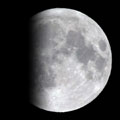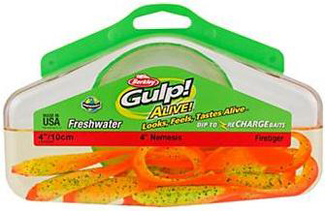| Berkley Gulp Nemesis | ||||
He was right. Gulps out-caught natural bait, because of the scent, and could be fished for repeated catches, unlike natural bait, he said. Most saltwater anglers now are familiar with Gulps, and often fish the bait instead of natural bait they used to fish. This summer, the new Gulp Nemesis reportedly made a splash at ICAST, the International Convention of Allied Sportfishing Trades. Anglers seemed to like them. The bait was originally developed in Australia, and is already on the market there. Nemesis is a combo of a Jerkshad and a Grub, probably the two most popular Gulps. The body, minnow-shaped, is similar to the Jerkshad, but has a Curl Tail, like on the Grubs. The tail imparts action to the bait both on the drop and when reeled in. Nemesis will be available in lengths 4 inches and 6 1/2 inches in numerous colors in either the Gulp packaging or Gulp Alive packaging.
Gulp Alive packaging, shown at left, is a hard plastic container filled with liquid that keeps Gulps even more filled with scent, and Gulps that have been fished can be placed back inside the container to “re-charge” them. To develop the original Gulps, Berkley reportedly researched chemoreceptors in fish to determine smells and tastes that made them bite, in tens of thousands of tests on the fish over 17 years. Shape, size, action and color mattered, too, so Berkley also researched that. Gulps are also 100-percent biodegradable, important for an artificial bait. Berkley Bedell founded the company Berkley in Spirit Lake, Iowa, in 1937, at age 16, when he took $50 from his paper route to begin selling flies he tied and other tackle to vacationing anglers, the company says. By the time he graduated from high school, he employed several girls to make flies, silkworm fishing line and wire leaders. After college and a stint in the Army Air Corps, he returned to civilian life in 1945, and grew the business, specializing in wire leaders. He eventually developed nylon-covered leaders and then nylon, monofilament fishing line. In 1959, he introduced Trilene monofilament, the well-known line. The company introduced fishing rods in the 1960s, soft-plastic baits in the 1980s and, in the next decades, Gulps. Berkley itself has changed the face of fishing. For more info about Gulp Nemesis, visit Berkley’s website. |
||||
|





 When Berkley
When Berkley  Gulp packaging is a plastic, sealable bag that keeps Gulps moist, maintaining the scent, and keeping the bait supple.
Gulp packaging is a plastic, sealable bag that keeps Gulps moist, maintaining the scent, and keeping the bait supple.
